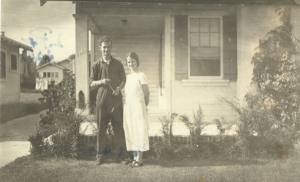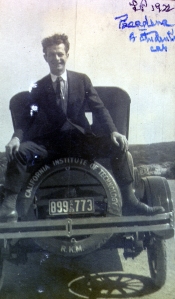[Ed Note: Over the past eleven years, one of the Pauling Blog’s areas of interest has been the exploration of different institutions with which Linus Pauling was affiliated. Posting series authored in support of this interest include examinations of Pauling’s time at The Center for the Study of Democratic Institutions, the University of California, San Diego, Stanford University, and the Linus Pauling Institute of Science and Medicine.
Pauling is, of course, most famously associated with the California Institute of Technology, his institutional home from 1922-1963. But attempting to develop a series of blog posts that delve into his institutional relationship with Caltech is a daunting task — in addition to being there for a long time, a great deal happened during those forty-one years.
Today, however, we begin to approach this weighty subject with the release of the first post in a lengthy series that will examine Pauling’s work as an administrator while also a member of the Caltech faculty. Among the more ambitious projects that the Pauling Blog has undertaken, this topic will be our primary point of emphasis from now until June 2019.]

Linus Pauling, 1937
Linus Pauling became Chairman of the Division of Chemistry and Chemical Engineering and Director of the Gates and Crellin Laboratories of Chemistry at the California Institute of Technology in 1937, succeeding long-time head A.A. Noyes. But before this time, he had taken on administrative responsibilities that would prepare him for the position and demonstrate to his superiors that he was a suitable candidate. By 1937, Pauling had also long since proven himself to be a world-class researcher and his rank had advanced accordingly: appointed Assistant Professor of Theoretical Chemistry in 1927, he was promoted to full professor just four years later. Importantly, Pauling’s research interests also led to the fostering of a strong working relationship with the Rockefeller Foundation during a key moment in institutional history.
Pauling’s demonstration of administrative skill and his research achievements, in tandem with his valuable ties to the Rockefeller Foundation, all contributed to the viability of his candidacy for division chair in the post-Noyes era.
Space
From the very beginning of Pauling’s tenure as chair, the need for and allocation of space ranked high as an ever-present concern. Prior to his appointment as division head, Pauling had gained useful experience with the administration of space. A member of a 1929 sub-committee charged with exploring ways to improve graduate instruction and research in physical chemistry, Pauling found that space devoted to graduate research was a pressing need and advocated that the division act accordingly. Later, Pauling himself dealt with shortages in space when compelled to move his laboratory to the astrophysics building beginning in 1932. Once Pauling became chair, these problems continued to linger, if softened somewhat by the construction of two new facilities, the Crellin and Church Laboratories.
In addition to raw square footage, the organization of available space was a regular topic of discussion. During his years as chair, A.A. Noyes sought to address the issue by organizing spaces according to research program, with areas for inorganic, organic, physical, and applied chemistry designated within the newly occupied Gates Laboratory. Pauling took issue with this approach, writing to Noyes in 1931 that the compartmentalization served “no useful purpose and would seriously weaken the Division by the introduction of artificial barriers.”

The Gates Laboratory, circa 1930s. Credit: Caltech Archives.
It was Pauling’s opinion that the division ought to continue promoting its well-recognized physical chemistry program instead, rather than incurring the risk that organic chemistry, a more emergent program, begin to overshadow an existing area of strength. “I am not opposed to the development of work in organic chemistry,” Pauling hastened to add, “But I feel that the work in physical and inorganic chemistry is one of the Institute’s strongest assets, and that development of organic chemistry should not be made at the expense of physical chemistry.”
Pauling even went so far as to put forth a suggested floor plan: the sub-basement, basement, and first floor should be devoted to physical chemistry, he felt, and the second and third floors to organic. Pauling further suggested that, as the division continued to grow to the point of overcrowding, a new building devoted to organic chemistry could be built, leaving physical and inorganic chemistry to occupy all of Gates. And as it turned out, Pauling’s vision proved accurate: a new building did come very soon, with construction of the Crellin Laboratory of Chemistry first proposed in 1935 and completed in 1938, not long after Pauling took up the chairmanship.
Salaries
In the years prior to his taking charge, Pauling also developed a reputation as an advocate for his fellow faculty; a stance that sometimes put him at odds with the Institute’s upper administration. In 1932, Robert Millikan, a Nobel laureate who was then the Chairman of the Caltech Executive Council, asked that the faculty vote to take a 10% pay cut in response to the economic depression then gripping the United States. Pauling vocally opposed this request, noting that only the Institute’s Board of Trustees could take such an action.
Three years later, Pauling voiced his support for raises that were pending for newly tenured colleagues Richard Badger and Don Yost, despite continuing budget woes. Pauling argued that the raises would help the division maintain its position as a leader within the profession by rewarding the successes of deserving researchers. As Pauling told Noyes, “I feel that in university administration, just is to be esteemed above expediency, and a satisfied staff above a balanced budget.” Pauling’s attention to faculty pay remained a hallmark of his tenure as chairman. Indeed, one of his final gestures as division leader, put forth in 1957, was a $1500 gift earmarked for Caltech faculty salaries.
Equipment
Another issue with which Pauling would grapple as chair was the imperative that the division be properly equipped, a problem that Pauling had encountered in his own research. In 1930, Pauling spent part of his summer at Arnold Sommerfeld’s Institute for Theoretical Physics in Munich, and upon his return to Pasadena, he requested institutional support for an electron-diffraction apparatus that was similar to Sommerfeld’s. As with his advocacy of faculty raises, Pauling’s request was in keeping with his ambition that the division maintain a position of prominence, this time in crystal structure research.
In making his case, Pauling argued that the research infrastructure at other campuses like the University of Chicago and the Massachusetts Institute of Technology were beginning to leave Caltech in their wake. He expressed this concern to Noyes, writing
I should not like to have this laboratory, which has played a significant part in the development of crystal structure since the early days, fall far behind the other and newer crystal structure laboratories in this country.
Pauling likewise believed that researchers themselves, rather than administrators, were in the best position to determine what sort of laboratory equipment was needed to carry out cutting-edge work. And though an admittedly risky proposition, he felt that each researcher should be given their own funding to do with as they pleased. Again to Noyes,
The most interesting experiments are the least safe – those which might give a surprising result, but which might fail. It is difficult to use these as an argument for buying new apparatus, inasmuch as success cannot be guaranteed. I feel nevertheless that these experiments are fully important as the routine ones.
Over time, Pauling continued to exert influence on decision-making related to the divisions’s general equipment needs, and became a formal member of its Equipment Laboratory Committee in 1935.
The Rockefeller Foundation
Without doubt, a major factor behind Pauling’s elevation to chairman was the strength of his relationship with the Rockefeller Foundation and, more specifically, its Director of the Natural Sciences, Warren Weaver. Pauling had been cultivating ties with the Foundation and Weaver for at least five years prior to his appointment as chair. In July 1932, he secured Rockefeller funding under what he later described as a “small grant” for $10,000 per year (nearly $170,000 in contemporary valuation) for crystal structure research. This grant was renewed twice and proved a crucial means of support during difficult economic times. After those three years had passed, Weaver told Pauling that the Foundation would no longer fund his current line of research, but that they would be interested in its biological applications.

Rockefeller Foundation administrator Warren Weaver.
As a result of these discussions, Pauling began redirecting his interests towards biological topics. In doing so, he requested $5,000 per year from Caltech’s Executive Council to supplement a potential $10,000 annual award from the Rockefeller Foundation, an amount that he ultimately received for three years beginning in 1935. Following the Foundation’s approval of his grant, Pauling wrote a thank you letter to Weaver in which he confided that he had already begun preliminary investigations on the structure of hemoglobin. Pauling added, “As I have read about the problems of biochemistry, I have become more and more enthusiastic about the possibilities of the application of our methods.” In short, he was smitten.
For Weaver, Pauling was part of the Foundation’s larger project of promoting biochemical research across the United States and also a valuable resource in deciding how to carry it out. In particular, Weaver solicited the perspective of researchers like Pauling on how best to coordinate training across institutions. One particular case involved an Antioch College researcher named O.L. Inman. Inman had requested Rockefeller support for studies of chlorophyll that were similar to what Pauling had done with hemoglobin, with the proviso that he would only do so if he could bring in someone who had worked on hemoglobin in Pauling’s lab. When asked for his input, Pauling told Weaver that Inman’s idea was doomed to failure, since chlorophyll lacked paramagnetic atoms. Weaver promptly heeded this advice, thus halting one potential instance of cross-institutional training.
In an undated note likely written in the mid-1940s, Pauling reflected on his relationship with the Rockefeller Foundation and the role that it played in influencing his research trajectory. “Perhaps,” Pauling wrote, “the remark from Weaver that my grant for molecular structure was all right, but that the main support was going in another direction, and the hint that application of m. s. [molecular structure] to biological problems might interest the Foundation greatly” had indeed made an impact on his decision-making.
However, Pauling did not agree with the notion that Weaver’s encouragement had diverted him away from more focused attention on chemical subjects. Rather, Weaver’s suggestion had opened up vital new territory of which Pauling had been unaware and that he subsequently became eager to explore. Pauling further described his relationship with the Rockefeller Foundation by likening it to a joke he had read in the Saturday Evening Post.
A young man and young woman were saying goodnight at her door. She said ‘I’ll give you a kiss – I owe it to you for bringing me all the way out to 155th Street, and next week I’m going to move out to 242nd.
Regardless of its impact on his research agenda, Pauling’s willingness to follow Weaver’s suggestions and the research funding strategies put forth by the Rockefeller Foundation would prove to be the tipping point in Pauling’s ascension to the chairmanship of the Division of Chemistry and Chemical Engineering at the California Institute of Technology.
Filed under: Pauling as Administrator | Tagged: A.A. Noyes, California Institute of Technology, Linus Pauling, Rockefeller Foundation, Warren Weaver | Leave a comment »














































